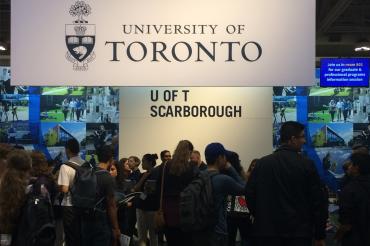Get a first look at U of T at the Ontario Universities' Fair

Published: September 23, 2016
The University of Toronto is welcoming thousands of eager high school students to its booth at the Ontario Universities’ Fair this weekend, answering questions about its three campuses and diverse faculties.
University-bound students and their parents also learned about a new campaign launched by the Council of Ontario Universities (COU) at the fair, which runs through the weekend at the Metro Toronto Convention Centre. The council is asking parents and students to fill out an online survey to begin thinking about what Ontarians need to prepare for the future.
“The challenge that we face is the world is changing so how do we make sure we keep up with those changes,” said David Lindsay, president of the council. “We’re a part of the province of Ontario’s economy and part of the infrastructure, and we want to make sure we’re working with all of our partners to build a bright future. The way to start that is to talk about people’s concerns. So we want to hear from people about their hopes, their fears, their aspirations.”
Results from the survey will be completed by next September, and will be used to further roundtable discussions with parents and student.

Every year, the fair attracts 120,000 high school students and their parents, four months ahead of the application deadlines in January.
This year, U of T got a bit more space on the exhibition floor to allow for more engaging conversations between university staff and students.
“The campuses and faculties are overwhelmed with traffic over the weekend,” said Richard Levin, executive director of Enrolment Services and the university’s registrar. “We managed to get a little more space, but we can effectively use much more than we currently have. We really want to make an effort to give students and their families a good experience. That needs space so they don’t have to wait as long, they can get their material and they can get their questions answered.”
This year the fair has students registering all their information into a “passport,” which contains a barcode that then gets scanned at a university’s booth.
In U of T’s case, the university also brought in a service that can help them customize communications with students.
“When it sends out a message, it will collect the students who just want information about engineering and send them a personalized message,” said Ken Withers, U of T’s director of university student recruitment. “If students have indicated they’re interested in Scarborough, then they’ll receive very tailored information just from Scarborough. So instead of receiving huge volumes of information that may not be applicable to them, the (service) helps us to tailor the message so students can get exactly what they need.”




